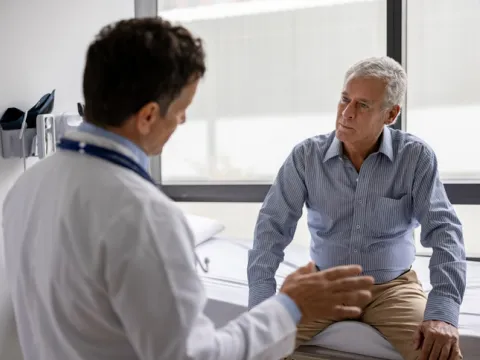- AdventHealth
Choose the health content that’s right for you, and get it delivered right in your inbox.

While strokes and aneurysms are two very different medical conditions, they are sometimes confused — especially when they cause similar symptoms. It’s important to keep in mind that both are serious and require immediate medical attention.
If you suspect you or a loved one is experiencing either a stroke or aneurysm, don’t delay — head to the emergency department immediately. Learn more about these two conditions, their symptoms and why immediate care is crucial for both from Guilherme Agnoletto, MD, a neurological surgeon with AdventHealth Tampa.
What is the Difference Between a Stroke and an Aneurysm?
A stroke is a disruption to the blood flow in the brain. This disruption can lead to damage to the brain.
There are three main types of strokes:
- Ischemic stroke: When disruption of blood flow is due to a blocked blood vessel in the brain
- Hemorrhagic stroke: A stroke caused by a ruptured blood vessel that leads to bleeding in the brain
- Transient ischemic attack (TIA): Also known as a “mini-stroke”, a temporary blockage in one of the brain’s blood vessels that clears up on its own
“Strokes are essentially plumbing problems with the blood vessels of the brain,” says Dr. Agnoletto. “Whether it’s blood not getting where it needs to go or oozing of blood where it shouldn’t be in the brain, strokes lead to issues of the brain not functioning.”
An aneurysm is caused by the bulging of a weak point in a blood vessel, which can increase the risk of rupture and bleeding. Aneurysms can happen throughout the body but are most common in the brain and aorta.
“Aneurysms don’t hold as much risk on their own,” says Dr. Agnoletto. “The problem is that when they rupture, they can lead to massive damage, quickly.”
What are the Symptoms of a Stroke vs. Aneurysm?
You can remember stroke symptoms with the simple acronym, BE FAST:
- B: Loss of balance or coordination
- E: Problems with eyesight
- F: Facial drooping or numbness, especially on one side
- A: Arm weakness or numbness, which can also impact just one side
- S: Speech problems or difficulty understanding
- T: Time to seek care
In addition to these symptoms, hemorrhagic strokes can come with sudden, severe headaches.
Aneurysms, similarly, can lead to headaches, often described as the “worst headache of your life.”
Symptoms can be similar for strokes and aneurysms. If you or a loved one is experiencing any signs or symptoms of either condition, it’s important to seek care to stop the damage from spreading.
“If you have any suspicion of a stroke or aneurysm, call 911 and get immediate care,” says Dr. Agnoletto. “As a comprehensive stroke center, we can offer all the care that is available for stroke patients 24/7. We also have the fastest response times so patients are not waiting to receive care.”
AdventHealth Tampa is a DNV GL Certified Comprehensive Stroke Center, the highest level of certification for stroke centers. This certification, renewed regularly, recognizes that AdventHealth provides complete care for every stage of stroke, including access to neurologists, neurosurgeons, equipment, treatments and rehabilitation services.
“Knowing and being attentive to the BE FAST symptoms is essential,” says Dr. Agnoletto. “If you suspect a stroke, it’s better to go to the emergency department and be wrong than not get the care you need.”
What is Treatment Like for Stroke?
Stroke patients receiving immediate care will likely receive treatment including:
- Intravenous, “clot-busting” medication
- Removal of the clot with a catheter
These treatments must be given within a few hours of the stroke to be effective.
“Every second counts because every moment there is no blood flow to the brain, neurons die.,” says Dr. Agnoletto. “Earlier interventions give patients the best chance of recovery. The most important thing is to try and limit the damage as much as possible.”
After emergency treatment, the care team will assess damage to the brain and recommend a stroke rehabilitation plan that may include physical, speech and occupational therapy to help the brain “rewire.”
How to Reduce Your Risk of Stroke
Practicing healthy habits, including quitting smoking, lowering blood pressure and speaking with your doctor about a family history of these conditions, can help lower your risk of both strokes and aneurysms.
In addition, you can further reduce your risk of stroke by:
- Eating a heart-healthy diet
- Exercising regularly
- Lowering cholesterol
- Managing chronic conditions like diabetes and heart disease
“We talk a lot about recognizing strokes, but prevention is the best choice,” says Dr. Agnoletto. “In an era where awareness of these health issues is high, self-care becomes even more important in avoiding stroke to begin with.”
Don’t Wait. BE FAST.
If you or someone you love is experiencing symptoms of a stroke, every second counts. Find emergency care near you.
About Dr. Agnoletto

Guilherme Agnoletto, MD, is a neurological surgeon who earned his medical degree at the Universidade do Sul de Santa Catarina School of Medicine in Tubarao, Santa Catarina, Brazil. Dr. Agnoletto completed his residency training in neurosurgery at the Instituto de Neurologia de Curitiba, Brazil and finished a second residency in neurosurgery at the University of Utah in Salt Lake City, UT, where he earned the rank of chief resident. Dr. Agnoletto had two fellowships, one in cerebrovascular and endovascular surgery at the Baptist Neurological Institute in Jacksonville, FL, and another in skull base and cerebrovascular neurosurgery at the University of Utah in Salt Lake City. He is the author of numerous professional publications, book chapters and oral and poster presentations. Dr. Agnoletto is dedicated to providing whole-person care to his patients, treating body, mind and spirit.




